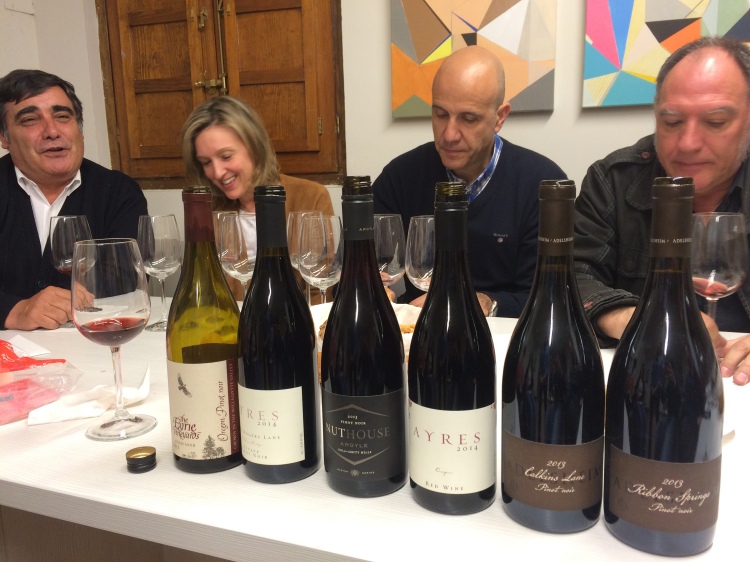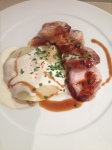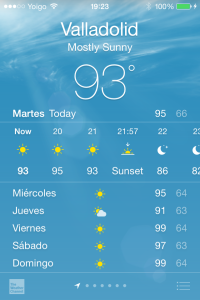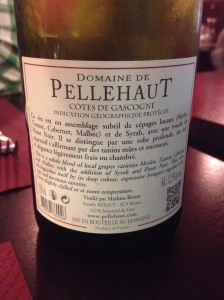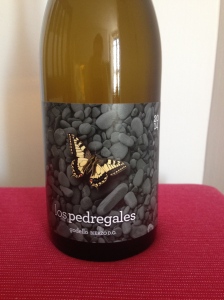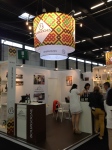By Saturday morning at 10 a.m. the temperature had reached 90° in Tournon-sur-Rhône. In our hot stupor we fumbled around looking for iced coffee and something substantial to eat. Croissants were located and we scooted down the road to Mauves in less than five minutes to meet with Domaine Coursodon.
Mauves is a small town with one church, one bar, one boulangerie and one charcuterie shop. The wine from the area had been called Vins de Mauves until the Jesuits changed the name to the current Saint-Joseph in the 17th century. The syrah produced here is opulent, spicy and arguably more elegant than its inky neighbor Cornas. This AOC, established in 1956, is a long, narrow stretch of 1,082 hectares that connects Saint-Péray and Cornas to the south with Condrieu and Côte-Rôtie in the north.
Noemi Coursodon could only offer us a taste of their St.-Joseph Silice as they were sold out of everything else. Her brother Jérome is winemaker. She showed us the steep granitic slopes above Mauves where they pick their 50+ years grapes. Their Silice was deep garnet with notes of dark berries and plum and the telltale signs of a terroir-driven syrah: peppery aromatics, power and elegance; very dry. We chatted about her upcoming nuptials for which she was quite nervous. It was looking more and more like the uncharacteristically early harvest could mean that the winery would be in full production mode at the same time she needed it for the reception. I wished her all the best as she sent us on our way to Domaine Bernard Gripa.

¨Ésta es una peña!¨Miguel said as we drove in. A peña is an old, usually abandoned, locale in the villages in Spain where young people go after hours to drink and socialize for free. Alas Monsieur Bernard´s wines were not free. In fact, they were more expensive than the other places we visited. As we approached, three finely dressed men in brightly colored salmon and blue pressed trousers were arranging cases of Gripa wine in a car trunk. They were from Paris, Belgium and the south of France, respectively. One said that I must try the Saint-Péray Les Figuiers. I took note.
Monsieur Gripa, a soft-spoken man, could finally inquire as to our presence when the last salmon trouser man shuffled out. Miguel was already poking around in places where he shouldn´t, imposing camera in tow with its wide strap slapping about. We made the international wine tasting gesture and Gripa escorted us downstairs, not yet sure about Miguel. With ever step, the temperature decreased 3°. Ten paces later we stepped into the cool dampness of serious old-school winemaking. The light was dim, the smell musty and the atmosphere damp.
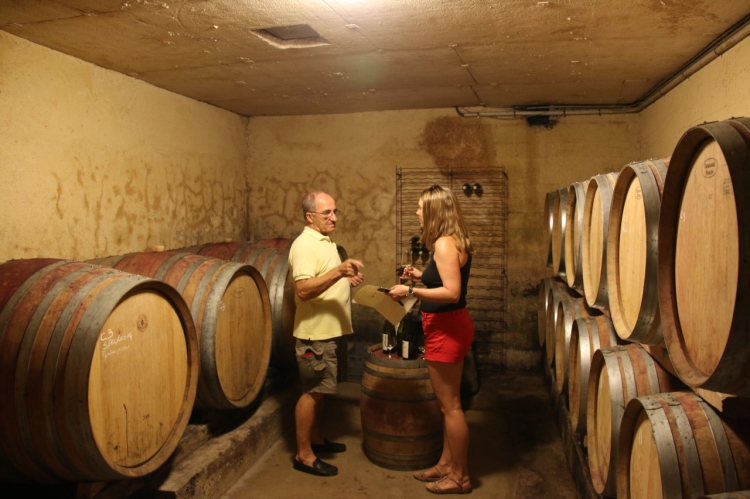
Monsieur Gripa and I
Gripa peered at us from behind his thick glasses now less cautious and more entertained. I could tell we were not his usual clientele. Miguel certainly was not I thought, as camera flashes suddenly ricocheted from the wet stony walls. I could hear him cursing himself ´No flash! No flash!´as he struggled with the len´s settings. Meanwhile, back at the barrique, Gripa slides me a glass. There were giant thumb prints and stains in the glass that could only have come from a Parisian in bright trousers. It did not matter. Gripa tasted with me, which I always appreciate. He scribbled figures on the back of my tasting notes. 60,000 bottles are produced annually. The family has farmed the land for six generations, but only vinified their own wine since 1974. The head winemaker is now his son, Fabrice.

The Photographer
Sure enough, I walked away with the Saint Péray and enjoyed it over lunch with country pate and salmon quiche. It had a racy acidity to match the wide, round ripe stone fruit and plenty of granitic minerality to go around. Very rich and full-bodied. A serious find from a man in serious pink pants. I too would have filled my trunk with this wine.
Later that night we had reservations at Comako restaurant in Tournon. We walked in and sure enough Monsieur Gripa was there just sitting down to eat with his wife. We told the server that we´d drink what he´s having. It was a Domaine des Remizières Cuvee Christophe White (Crozes-Hermitage), rich and viscous, high alcohol and acid with huge stone fruit and melon.
There is a very different culture in Spain surrounding winemaking than in the northern Rhône. Excluding the small, traditional winemakers in Spain, the Spanish wineries strive to be big and glamorous and sell relatively inexpensive wine (less than €8 ex-cellar). Here in this corner of the world, the wineries were peñas and you´d be hard-pressed to find a bottle of wine for less than €18 ex-cellar.
So where are all the Bernard Gripas of the world? I guess you really have to go looking for them. And bring a glass.
Tasted at Vineum, Tain l’Hermitage on August 8, 2015:
Maison Paul Jaboulet Aîné 2011 Grenache Blanc and Clairette (Chateauneuf-du-Pape) 14.5% abv. Thick legs and a medium lemon color. Bouquet of lemon, oak, soft honeydew with vanilla ice cream. On the palate it is full bodied with medium plus acidity, waxy, textured like a finely woven silk scarf.
Maison Paul Jaboulet Aîné 2013 Domaine de Grands Amandiers Viognier (Condrieu) 14% abv is described by Guillaume as fresh, to be enjoyed young (less than two years) and with goat cheese. It was vinified in stainless steel and been untouched by oak. This is obviously a more modern winemaking style employed to highlight the freshness and roundness of the viognier fruit. It is barely a medium yellow with orange hues. At first whiff it smells oddly like a college dorm room with strong floral notes of dandelion and sticky marijuana. There is also some savory richness that I could only describe as duck or guinea fowl fat. Too much country pate in the air perhaps. There as an even minerality throughout the wine and a medium acidity. Enters sweet and smooth and coats the palate.
Maison Paul Jaboulet Aîné 2012 Le Chavalier de Sterimberg Marsanne and Roussanne (Hermitage) 13.5% abv can be drunk young but will keep for 10 years and over time will develop notes of nuts and honey. The wine was vinified in cement and clarified with egg before it spent eight months in 15% new oak and 85% second cycle barrels and then goes through élevage. It is a medium yellow color with green glints. Bouquet is ripe yellow and orange citrus, peach with a lot of structure and minerality. Acidity is medium.
Maison Paul Jaboulet Aîné 2007 Domaine Raymond Roure Syrah (Croze-Hermitage) 13% abv from hilly part of Crozes. Medium garnet with with orange glints. Brick. Bouquet of berry, kernel, cranberry, cinnamon, warm sweet baking spices and slight vegetal like tinned tomatoes. On the palate cherry and pomegranate. 12 months in oak. Will improve over 10 years. Only 3.5 hectares of vines between 40-60 years old on very steep granitic south facing slope. Purchased from the Roure family in 1996. Monsieur Roure was the plot’s prolific winemaker for many years and so the Jaboulet house, upon purchasing the plot decided not to mess with a good thing and retained the original name.
Maison Paul Jaboulet Aîné 2010 Domaine de la Croix du Vigne Syrah (Saint-Joseph) 13.5% abv is a deep ruby with dark berry, savoury, kernel, baking spices, oregano, crackling BBQ sauce, skewers with fat drippings into open flame, opulent and lush. High acid with sweet velvety tannins.
Maison Paul Jaboulet Aîné 2010 Domaine des Pierrelles Syrah [(Côte-Rôtie, (Côte Blonde)] 13.5% is a medium garnet syrah so elegant in its weight and finesse that it reminded me more of a Sonoma Pinot. There was red cherry fruit tightly interwoven with kirsch, fresh prune, tinned tomatoes, fatty protein, savory spice and fire and campfire smoke.

